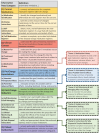Patient Information Needs During Ambulatory Medication Changes: A Qualitative Study
- PMID: 40697632
- PMCID: PMC12279303
- DOI: 10.17294/2330-0698.2129
Patient Information Needs During Ambulatory Medication Changes: A Qualitative Study
Abstract
Purpose: We performed interviews with patients and caregivers to explore whole-person, whole-regimen information needs at times of routine outpatient medication changes. We categorized information needs in this relatively unstudied context and identified which needs were commonly recognized as insufficiently met.
Methods: We explored the content of the semi-structured interviews, which involved nine patients and two caregivers of pediatric patients, all of whom experienced a recent medication change in the outpatient setting of a large urban academic healthcare system. We used inductive thematic analysis to organize information needs into categories to identify key information gaps.
Results: We identified five categories of patient information needs: (1) medication self-administration, (2) clinical reasoning informing the medication change, (3) pre-medication change expectations, (4) post-medication change behaviors, and (5) patient role and responsibilities in safe medication management. Through these categories, we highlighted five themes from which participants frequently described receiving insufficient information: (1) medication history, (2) anticipatory guidance about possible adverse effects, (3) self-monitoring and self-managing instructions, (4) safe information seeking, and (5) safe disposal of surplus medications.
Conclusions: Our findings illustrate patient information needs at times of ambulatory medication changes and identify vulnerabilities where these needs may be insufficiently met. Providing tailored information at times of ambulatory medication changes might support patient engagement with medication safety practices and ultimately reduce patient harm associated with adverse medication events. Further research is needed to confirm these gaps in larger studies and examine this question within special populations, including pediatric caregivers and patients with limited English proficiency.
Keywords: ambulatory care; medication self-management; patient information needs; patient perspectives; qualitative research.
© 2025 Advocate Aurora Health, Inc.
Conflict of interest statement
Conflicts of Interest: The authors declare the following financial interests/personal relationships, which may be considered as potential competing interests: EG, YY, RJ, NLM, JLS, and SIP received funding support from AHRQ R21 HS26584, which was the primary funding for the parent CancelRx evaluation study. During her contributions to this study, EG received funding support from the Dean’s Year of Research and Primary Care Leadership Track at Johns Hopkins University School of Medicine. During her contributions to this study, JLS was supported by a T32 award from the National Heart, Lung, and Blood Institute (5T3HL007180, PI: Maruthur). The institute was not involved in conducting this research or in the preparation of this article. JLS is supported as a co-investigator on a research project funded by Novo Nordisk Inc, the primary aim of which is to create and pilot a clinical decision support tool for use by primary care providers during discussion about obesity. JLS is also supported by the Ardmore Institute to perform an implementation study evaluating an employee health program for hypertension management. Neither of these projects are addressed or referenced in this manuscript. VBH and RM report no competing interests.
Figures
Similar articles
-
Adapting Safety Plans for Autistic Adults with Involvement from the Autism Community.Autism Adulthood. 2025 May 28;7(3):293-302. doi: 10.1089/aut.2023.0124. eCollection 2025 Jun. Autism Adulthood. 2025. PMID: 40539213
-
Factors that influence parents' and informal caregivers' views and practices regarding routine childhood vaccination: a qualitative evidence synthesis.Cochrane Database Syst Rev. 2021 Oct 27;10(10):CD013265. doi: 10.1002/14651858.CD013265.pub2. Cochrane Database Syst Rev. 2021. PMID: 34706066 Free PMC article.
-
How lived experiences of illness trajectories, burdens of treatment, and social inequalities shape service user and caregiver participation in health and social care: a theory-informed qualitative evidence synthesis.Health Soc Care Deliv Res. 2025 Jun;13(24):1-120. doi: 10.3310/HGTQ8159. Health Soc Care Deliv Res. 2025. PMID: 40548558
-
Sexual Harassment and Prevention Training.2024 Mar 29. In: StatPearls [Internet]. Treasure Island (FL): StatPearls Publishing; 2025 Jan–. 2024 Mar 29. In: StatPearls [Internet]. Treasure Island (FL): StatPearls Publishing; 2025 Jan–. PMID: 36508513 Free Books & Documents.
-
Interventions for interpersonal communication about end of life care between health practitioners and affected people.Cochrane Database Syst Rev. 2022 Jul 8;7(7):CD013116. doi: 10.1002/14651858.CD013116.pub2. Cochrane Database Syst Rev. 2022. PMID: 35802350 Free PMC article.
References
LinkOut - more resources
Full Text Sources
Miscellaneous


